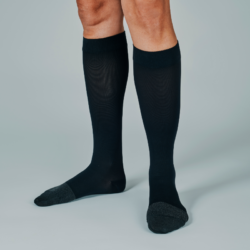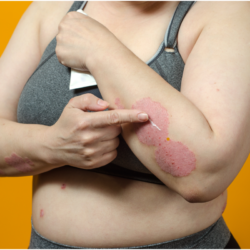Vitiligo is an autoimmune skin disease that affects around 1% of the world’s population. A recent study published by the British Association of Dermatologists explores the potential impact of house dust mites on this condition. This article provides a full overview of the results of this ground-breaking study.
What is Vitiligo?
Vitiligo is an autoimmune dermatological disease that manifests itself as depigmented patches on the skin. This depigmentation results from the detachment and subsequent loss of melanocytes, the cells specialising in the production of melanin, a pigment essential for skin colouration. This phenomenon is complex and can be influenced by genetic, environmental and immune factors.
Molecular mechanism
At a molecular level, the detachment of melanocytes from the epidermis is often associated with the degradation of E-cadherin. This adhesion protein is crucial for maintaining the structural integrity of epithelial cells. Its alteration is driven by protease enzymes, notably matrix metalloproteinase-9 (MMP-9), a key enzyme involved in regulating cell adhesion and inflammation.
House dust mites and their impact on vitiligo
House dust mites are ubiquitous micro-organisms present in many indoor environments. They are particularly well known for their high protease activity, which enables them to break down proteins in order to feed. This enzymatic activity not only affects the respiratory and digestive systems, but can also have a significant impact on the skin.
What are mites?
Mites are tiny arthropods, often invisible to the naked eye, belonging to the arachnid family. They are commonly found in homes, particularly in places where dead skin cells accumulate, such as beds, carpets and upholstered furniture. These microscopic creatures feed on particles of human and animal skin. Although harmless to most people, dust mites can cause allergies in some people, including sneezing, skin rashes and eye irritation. Their ubiquitous presence in human habitats makes house dust mites a subject of interest in public health and medical research.
Relationship with Vitiligo
Recent studies have shown that house dust mites are capable of disrupting cell junctions in the epidermis. This disruption is mediated by the degradation of E-cadherin, which in turn causes the detachment of melanocytes. In the context of vitiligo, this action of mites takes on particular importance. The degradation of E-cadherin by mite proteases, in particular in synergy with the activation of MMP-9, could act as a catalyst for the detachment of melanocytes and therefore for the onset or worsening of vitiligo symptoms.
Vitiligo and mites: New scientific discovery
A recent scientific publication has highlighted an unexpected role for mites in the pathogenesis of vitiligo, an autoimmune disease which affects around 1% of the world’s population and is characterised by loss of pigmentation in the skin. According to this study, not only are mites present in human skin, but their enzymatic activity can also influence the dynamics of cutaneous immunity.
Implicit mechanisms
The study found that the impact of house dust mites on the skin is mediated by the activation of Toll-like receptor 4 (TLR-4), a key component of the innate immune system. This activation leads to a subsequent increase in the activity of matrix metalloproteinase-9 (MMP-9), an enzyme associated with the degradation of E-cadherin. E-cadherin is a crucial protein for cell adhesion and the cohesion of epidermal cells. The degradation of E-cadherin leads to the detachment of melanocytes from the epidermis, thus contributing to the depigmentation observed in vitiligo. It has been shown that blocking MMP-9 can attenuate this effect, suggesting a targeted therapeutic potential.
Vitiligo is a chronic autoimmune disease affecting melanocytes, mainly in the skin and mucous membranes. The disease results from the interaction between genetic and environmental factors, leading to the autoimmune destruction of melanocytes. Defects in melanocyte adhesion and increased oxidative stress exacerbate the immune response in vitiligo. This disorder, which is both cosmetically disfiguring and psychologically burdensome, is chronic, with variable responses to treatment and frequent recurrences, reducing quality of life. Treatments must aim to provide longer periods of remission, prevent recurrences, ensure good cosmetic results and patient satisfaction. Recent advances in understanding the complex pathogenic mechanisms of vitiligo at molecular and genetic level offer new therapeutic perspectives.
Increased sensitivity in vitiligo patients
The most revolutionary aspect of this study is that it also revealed an increased sensitivity of vitiligo skin to the protease effects of mites, compared with healthy skin. This highlights the possibility that in some individuals with a genetic predisposition to vitiligo, house dust mites could act as an environmental trigger.
Therapeutic implications and conclusions
Identifying the role of mites in vitiligo is potentially revolutionary. It opens the door to the development of new therapeutic strategies, in particular MMP-9 inhibitors, which could be useful in controlling or even reversing the progression of the disease. However, it should be noted that although these results are promising, they need to be validated by more in-depth clinical studies.
How do mites affect the skin?
In the context of the study in question, it was shown that house mites possess a strong protease activity capable of disrupting the integrity of cell junctions in the skin. This disruption is more marked in vitiligo due to the degradation of E-cadherin, a crucial adhesive protein. The result is the detachment of melanocytes and, consequently, the loss of pigmentation characteristic of this autoimmune disease.
In sum, this ground-breaking research has highlighted a possible mechanism of action of mites in the pathogenesis of vitiligo, and identified MMP-9 as a potential therapeutic target. However, further studies are imperative to validate these findings and assess their clinical relevance.
How important is MMP-9 in vitiligo?
Matrix metalloproteinase-9 (MMP-9) is a protease enzyme that plays a crucial role in modulating cell-cell and cell-matrix interactions. In vitiligo, activation of MMP-9 has been linked to disruption of cell junctions and detachment of melanocytes from the epidermis. More specifically, MMP-9 activation can be stimulated by engagement of Toll-like receptor (TLR)-4, a key molecule in the innate immune system, in response to environmental cues such as house dust mites.
Are there any current treatments that target MMP-9?
Although there are no approved treatments specifically designed to target MMP-9 in vitiligo, some preclinical and clinical studies are underway to assess the efficacy of MMP-9 inhibitors. The study mentioned in the previous article demonstrated that blocking MMP-9 with a selective inhibitor can partially restore E-cadherin expression and inhibit mite-induced detachment from melanocytes. This suggests that MMP-9 inhibitors could offer a new therapeutic avenue in the management of vitiligo.
Preventive advice to reduce exposure to mites
To limit exposure to house dust mites, it is advisable to adopt effective cleaning methods and make appropriate lifestyle choices. Here are a few suggestions:
- Regular cleaning: Vacuum carpets, upholstered furniture and curtains frequently to reduce the presence of dust mites.
- Use dust mite covers: Cover mattresses and pillows with special anti-dust mite covers.
- Wash sheets at high temperature: Regularly wash sheets, pillowcases and blankets at a temperature of at least 60°C to kill dust mites.
- Keep humidity low: Use a dehumidifier to keep humidity levels below 50%, as dust mites thrive in damp environments.
- Air rooms: Open windows regularly to air rooms and reduce humidity.
These practical measures can help to significantly reduce the amount of dust mites in your home environment.
What treatments are currently available for vitiligo?
Current treatments for vitiligo aim to restore skin colour or even out skin tone. Medical options include topical corticosteroid creams, immunomodulators, and phototherapy, which uses ultraviolet light to stimulate skin cells. These methods can be effective, but they have limitations, including variable response times and potential side effects. Natural remedies, such as the use of certain plants or dietary changes, are being explored by some, although their effectiveness is not always scientifically proven. Treating vitiligo is often a long-term process, requiring a personalised and sometimes combined approach.
The psychological impact of vitiligo
Vitiligo, although primarily a dermatological condition, has a significant impact on the psychological health of those affected. Skin depigmentation can be a source of embarrassment, social stigma and psychological distress. Several studies have highlighted an increased incidence of disorders such as anxiety, depression and low self-esteem in people with vitiligo compared with the general population.
Social stigma and quality of life
The presence of depigmented skin patches can lead to considerable social stigmatisation. Individuals with vitiligo may be subject to unpleasant comments, stares or even discrimination, which can lead to a marked reduction in quality of life. In some cultures, where great importance is attached to physical appearance and skin colour in particular, the psychological impact can be even more pronounced.
Recently, studies have also explored the effectiveness of natural compounds as supplements in alleviating the psychological problems associated with vitiligo. These compounds, which are rich in antioxidants, could play a role in reducing oxidative stress, which is often linked to both dermatological and mental disorders:
- Quercetin, a natural antihistamine.
- American skullcap
- Kaempferol contained in witch hazel leaves, for example
- EGCG contained in green tea
- Curcumin
- Cannabidiol or CBD
- Glycyrrhizin and Glycyrrhetinic Acid
The use of these natural supplements, as a complement to conventional treatments, could help to improve the mental state of patients, thereby reducing the anxiety and depression associated with the disease. This integrative approach underlines the importance of comprehensive management of vitiligo, treating both the physical and psychological symptoms.
Using cosmetics to even out skin tone
Faced with the psychological and social challenges posed by vitiligo, many patients look for solutions to even out their skin tone. One such solution is the application of specialised cosmetics.
Corrective make-up
Corrective make-up is often used to mask depigmented areas. These products are specifically formulated to provide high coverage and long-lasting hold. Some of these products are also water and transfer resistant, offering a longer-lasting solution for the individuals concerned.
How do you hide vitiligo?
To assist people affected by vitiligo in their search for suitable cosmetic solutions, here is a table summarising the products available on the “Soin et Nature” website. This selection includes various types of make-up designed to meet the specific needs associated with this dermatological condition.
| Product name | Type of product |
|---|---|
| Covermark Finishing Powder | Loose Powder |
| Covermark Leg Magic Foundation | Foundation |
| Covermark Concealer Stick | Concealer Stick |
| Covermark Face Magic Foundation | Foundation |
| Covermark Leg Magic Fluid | Fluid Foundation |
| Covermark Classic Foundation | Foundation |
| Vichy Dermablend Fluide | Fluid Foundation |
| Vichy Dermablend Covermatte | Compact Powder |
| Vichy Dermablend 3D | Foundation |
For more details on these products, you can go directly to the make-up category of our online pharmacy.
Self-tanners and DHA
Self-tanning products containing dihydroxyacetone (DHA ) are sometimes used to temporarily colour the skin and reduce the contrast between affected and healthy areas. Although this method is not permanent, it can provide temporary psychological relief and improve quality of life.
Read more:
- https://pubmed.ncbi.nlm.nih.gov/37140010/
- https://www.ncbi.nlm.nih.gov/pmc/articles/PMC9854903/





